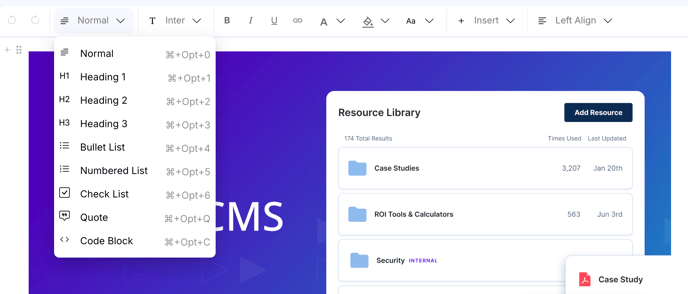Setting up Pages in Your Resource Library (CMS)
How to use Pages to organize and display information for your team.
Pages are a part of the Resource Library (CMS), which is only included with the Enterprise package of Accord.
To learn more about our pricing and packaging options, contact sales@inaccord.com.
What's in this Article?
What are Pages?
Pages allow you to create dedicated spaces to organize and display information for specific topics, features, or initiatives. They provide a centralized location where your team can access comprehensive information and context on important subjects.
Pages can be organized for a variety of purposes, such as:
- Product enablement (e.g. feature launches, product updates)
- Competitive intelligence (e.g. competitor analysis, market positioning)
- Training materials (e.g. messaging guidelines, best practices)
- Campaign resources (e.g. marketing initiatives, sales plays)
Creating a Page
Only Accord workspace admins have the ability to create Pages within the Resource Library.
In order to create a Page, simply:
- Navigate to the Resource Library section of Accord
- Click "Add Resource"
- Click "Page" and go through the setup

You can also do this from any folder within your Library. Pages can be set an internal-only, or made visible to customers.
Adding Content to a Page
Pages include a standard text editor with controls you should be familiar with for text formatting, colours, tables, etc.

Best Practices for Pages
When building out your Page, please consider the following:
Set a Clear and Descriptive Title
Your Page title should immediately communicate its purpose. Use specific, descriptive names like "Q4 Product Launch - Feature X" rather than generic titles like "New Feature."
Write a Comprehensive Description
A detailed description helps team members understand when and why to use this Page. Include the target audience, purpose, and key information they'll find within.
Maximize the Editable Text Area
The text area at the top of your Page is perfect for:
- Executive summaries of complex topics
- Key messaging and positioning guidelines
- Process overviews and step-by-step instructions
- Quick reference information that doesn't require separate Resources
Structure Information Logically
Organize your Page content in a logical flow that matches how your team will consume the information. Consider using headers and sections to break up content, such as:
- Overview
- How it works
- Messaging guidelines
- Competitive intelligence
- Pricing information
- Related resources
Think About Your Audience
Always consider who will be using this Page and how they'll search for and consume the information. Structure the content to align with their workflow and information needs.
Build for Discoverability
Use clear, searchable language and relevant keywords that your team will naturally use when looking for this information.
Keep Content Current
Pages often contain time-sensitive information like product updates, pricing, or competitive intelligence. Establish a regular review schedule to ensure accuracy.
Maintain Consistency
Develop templates or standard formats for similar types of Pages (e.g. all product enablement Pages follow the same structure) to help users know what to expect.
Regular Review and Maintenance
Information evolves and processes change. We recommend reviewing your Pages monthly or quarterly, depending on how frequently the information changes. Remove outdated content and update messaging as needed.